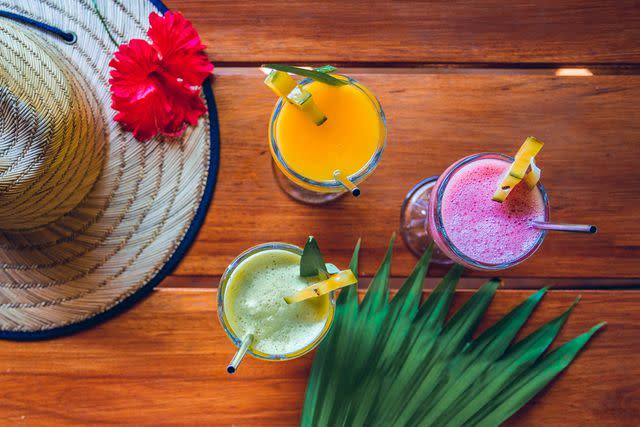This Stunning Peninsula in Costa Rica Is a 'Blue Zone' Where Many Residents Live Till 100 — Here's Their Secret
Costa Rica's Nicoya region has 900 residents over 90 right now. Here's how the area has become a coveted "Blue Zone."

EZEQUIEL BECERRA/AFP via Getty Images
Clementina Espinoza, 91, takes care of her garden in Nicoya, Costa Rica, August 27, 2021. - Espinoza and her husband Agustin, 100, live in one of the five Blue Zones of the world, where longevity is a characteristic in a higher than usual number of people.Nicoya, on the Atlantic side of Costa Rica, is a city, a canton (a municipality of sorts), and an entire peninsula of Costa Rica. It’s also a place death forgets. Named a Blue Zone, which is a place where people regularly live past the age of 100, the average life expectancy in Nicoya is 80 years (it’s 76.4 years in the U.S.)
“They have the world’s lowest rate of middle-age mortality,” said Dan Buettner, journalist and founder of Blue Zones. “A Nicoya 60-year-old has an eight-fold better chance of reaching 100 than an American does.” So what keeps Nicoya residents living long, long lives? Their hardworking but low-stress lifestyles are largely at play, the experts report.

Courtesy of Visit Costa Rica
Residents of Nicoya Peninsula live longer in large part due to the region’s calcium-rich water, healthy eating, family-based living, outdoor activity, and commitment to a pura vida lifestyle. The pura vida approach means slowing down, eliminating stress, and taking time to connect with nature, friends, and family. “Life in Nicoya is more relaxed, people have a greater sense of community, and as a result, stress is significantly reduced,” said Simón Carrillo, regional representative of the Nicoya Peninsula at the Costa Rican Tourism Board.

Courtesy of Visit Costa Rica
The average diet in Nicoya is simple, hearty, and largely plant-based: rice, corn, beans, squash, and fresh fruit are the staples of any Nicoya meal, with meat and poultry often not included. “In their day-to-day routine, locals here mainly focus on tending to their agricultural work, which serves as their primary source of income,” Carillo said. When it's time for a meal, they whip up dishes using the fresh ingredients they have on hand.

Courtesy of Visit Costa Rica
“Corn, beans, and squash, a.k.a. the three sisters of Mesoamerican agriculture, is arguably one of the healthiest diets to exist,” Buettner emphasized. “Nicoyans also drink significantly less milk than other Costa Ricans.”
Those in Nicoya, as mentioned, are used to agricultural work, and often work tirelessly outdoors harvesting crops — getting plenty of sunlight.

Courtesy of Visit Costa Rica
“Sunlight triggers a reaction that converts cholesterol into vitamin D,” Buetttner said. “Most Americans are vitamin D deficient, which is associated with depression, diabetes, obesity, and a suboptimal immune function. Vitamin D, when coupled with calcium [from their calcium-rich water], helps keep bones strong.”
Buettner noted that this hard work doesn’t go away for many of a certain age, citing a 90-year-old woman he recently saw cutting down her grass with a machete. The work doesn’t stop, but neither do the residents of Nicoya. But that doesn’t mean play takes a backseat. Many residents have a preference for a simpler and more relaxed lifestyle, placing importance on spending quality time with family and friends, immersing themselves in the stunning natural surroundings, and finding joy in life's small pleasures. “Life in these parts tends to be unhurried and intimately connected with the beauty of the natural world,” Carrillo said.

Courtesy of Visit Costa Rica
Besides the head city of Nicoya, where a few centenarians live, most centenarians of the province live in smaller towns throughout the peninsula. Many of them have never driven a car, and in fact, car transportation in some of these parts is relatively new, as is the supporting infrastructure. Because of this, “physical activity is constant, since the general culture depends less on vehicles and people often walk a lot,” Carillo said. That’s not the only constant physical activity the people of Nicoya partake in. Surrounded by the natural beauty of the area, you'll often find them surfing, exploring nature and hiking trails, or simply swimming and laying by the beach. This daily physical movement coupled with reduced stress also means they are great sleepers, which has plenty of effects on one’s health, potentially including lowered stress, lowered blood pressure, and lower chances of heart disease.

Courtesy of Visit Costa Rica
Buettner also emphasized that Nicoya residents aren’t just eating right and moving right — they’re also connecting with others and finding purpose in later life. “Don’t overlook the power of finding one’s purpose, or as locals call it ‘plan de vida,’” he said. “They feel the want and need to contribute to the greater good and support their families and friends. This purpose is their reason to get up in the morning and can add up to seven good years to your life. One of the most dangerous years of your life is the year you retire because of a sudden lack of purpose.”

Courtesy of Visit Costa Rica
As for the future of the Blue Zone, it seems this region will be considered Blue for many years to come; as of 2021, according to the Costa Rican Ministry of Health, more than 900 people over 90 had been recorded, along with more than 5,000 residents over 75, the majority of whom enjoy good health in their old age. More sunlight, more water, more good food, more physical activity, and more community — that seems to be the makings of a Nicoya centenarian.
For more Travel & Leisure news, make sure to sign up for our newsletter!
Read the original article on Travel & Leisure.

